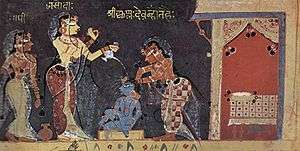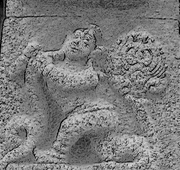Bala Krishna
Bala Krishna (Sanskrit: बाल-कृष्ण bālakṛṣṇa, literally "child Krishna") sometimes translated to "Divine Child Krishna",[1][2] or Bal Gopal is historically one of the early forms of worship in Krishnaism and an element of the history of Krishna worship in antiquity. This tradition is considered as a part of the number of other traditions that led to amalgamation in a later stage of the historical development and culminate in worship of Radha Krishna as Svayam bhagavan. Other monotheist traditions are Bhagavatism and Cult of Gopala, that along with Cult of Krishna-Vasudeva form the basis of the current tradition of the monotheistic Krishna religion.[1] The worship of Balakrishna, the divine child, while a significant feature of the Krishna religion, often receives less attention,[3] however it is one of the most popular deities of Krishna in many parts of India today.[1] Early evidence of such worship can be found or as early as the 4th century BC according to evidence in Megasthenes and in the Arthashastra of Kautilya, when Vāsudeva (as the son of Vasudeva was worshiped as supreme Deity in a strongly monotheistic format, where the supreme Being was perfect, eternal and full of grace.[4]
_as_Infant_Krishna_-_Walters_543081.jpg)

Some of the miraculous acts of the form are notable. It is believed that Putana, a huge monster, was killed when the baby Krishna sucked her life from her by taking the poisoned breast she offered him.[5]
Bala-Krishna is often depicted as a small child crawling on his hands, and knees or dancing with a piece of butter in his hand.[6][7]
In the Bhagavad Gita, it appears Krishna is teaching a universal monotheistic religion of personal God and reveals himself to be all-God, svayam bhagavan. The childhood episodes of Krishna's legend became the focus of the medieval devotional cults that started to develop in a number of movements in medieval India.[5]
Monuments


The prominent historical Site is the Balakrishna temple in Hampi built by the ruler Krishnadevaraya in 1513. Main altar of the temple is dedicated to Bala Krishna and it is one of the few temples where stories of Puranas were carved on the walls of the temple and its main tower.[8] Other notable image is murti of Bala Krishna worshiped by Madhvacharya in his Sri Krishna Matha of Udupi. It is believed the form was transported by sea from Dwarka.[9] Legend has it that this was the very same murti which wife of Krishna, Rukmini, had worshipped. Liberation from the world of matter required grace and dependence on God and active devotion, such as worshipping the Lord in the form of an icon (murti). Madhva placed such an icon of Bala Krishna in his monastery in Udipi where it remains to be seen by pilgrims to this day.[10] Ever since the image was installed, Udupi has been steadily gaining in importance as a centre of pilgrimage. It is believed Madhvacharya saved drifting ship, from which he received in gratitude two large balls of chandan clay used as a ballast. To the amazement of all in each there was confined a deity form, one of Krishna and one of Balarama, the deity of Krishna with a churner in his hand was called Bala Krishna and was installed in the main Udupi shrine. The sacred lamps at this statue of Bala Krishna recovered from the sea in the 14th century were lit by Madhvacharya himself and are being kept burning as a part of the ritual continuously, and that is for the last 700 years.[11][12]
Hinduism in the West
At the very beginning of his work to establish Hindu Krishna temples in the Western World Bhaktivedanta Swami Prabhupada wanted to establish a prominent temple in New York City dedicated to Bala Krishna, even before starting ISKCON he wrote to one of his supporters in India:[13]
I think therefore that a temple of Bala Krishna in New York may immediately be started for this purpose. And as a devotee of Lord Bala Krishna, you should execute this great and noble work. Till now there is no worshipable temple of the Hindus in New York, although in India there are so many American missionary establishments and churches.
— to S. Morarji, 1965[13]
Currently it is a popular deity among many Hindu followers of various traditions in the West, including International Society for Krishna Consciousness.
See also
- Christ Child
- Radha Krishna
- Shrinathji
- Hindu scriptures
- Bhagavad Gita
- Bhagavata Purana
- Bhagavata
- Svayam Bhagavan
- Nezha
- Keev
Footnotes
- KLOSTERMAIER, Klaus K. (2005). A Survey of Hinduism for Bala Krishna. State University of New York Press; 3 edition. p. 206. ISBN 0-7914-7081-4.
Present day Krishna worship is an amalgam of various elements. According to historical testimonies Krishna-Vasudeva worship already flourished in and around Mathura several centuries before Christ. A second important element is the cult of Krishna Govinda. Still later is the worship of Bala-Krishna, the Divine Child Krishna - a quite prominent feature of modern Krishnaism. The last element seems to have been Krishna Gopijanavallabha, Krishna the lover of the Gopis, among whom Radha occupies a special position. In some books Krishna is presented as the founder and first teacher of the Bhagavata religion.
- Gopal, Madan (1990). K.S. Gautam (ed.). India through the ages. Publication Division, Ministry of Information and Broadcasting, Government of India. p. 75.
- BASHAM, A. L.; Singer, Milton; Ingalls, Daniel H. H. (May 1968). "Review:Krishna: Myths, Rites, and Attitudes.". The Journal of Asian Studies. 27 (3): 667–670. doi:10.2307/2051211. JSTOR 2051211.
- Hastings 2003, pp. 540–42
- Miller, Barbara Stoler; Hawley, John C. (1997). Love Song of the Dark Lord. New York: Columbia University Press. ISBN 0-231-11097-9.
- Students' Britannica India By Dale Hoiberg, Indu Ramchandani p.251
- Satsvarupa dasa Goswami (1998). "The Qualities of Sri Krsna". GNPress: 152 pages. ISBN 0-911233-64-4. Cite journal requires
|journal=(help)CS1 maint: ref=harv (link) - Also Balakrishna refers to the name of the Telugu Actor "Krishna Temple". www.hampi.in. Archived from the original on 2008-02-24. Retrieved 2008-05-25.
- Dasa, Kundali. "Back to Godhead - How Krishna Came to Udupi". btg.krishna.com. Archived from the original on October 12, 2007. Retrieved 2008-05-25.
- Knott, Kim (1998). Hinduism: a very short introduction. Oxford [Oxfordshire]: Oxford University Press. p. 33. ISBN 0-19-285387-2.
- "IndiaPilgrim". www.indiapilgrim.in. Archived from the original on 30 May 2008. Retrieved 2008-05-25.
- C. M. Padmanabhacharya, Life and Teachings of Sri Madhvachariarya, 1983
- Goswami, Satsvarupa dasa (2002) [1980-82]. Srila Prabhupada Lilamrta Vol 1-2. GN Press. p. Ch.13 "Struggling Alone". ISBN 0-89213-357-0.
Sources
| Wikimedia Commons has media related to Bala Krishna. |
- Hastings, James Rodney (2nd edition 1925-1940, reprint 1955, 2003). Encyclopedia of Religion and Ethics. John A Selbie (Volume 4 of 24 ( Behistun (continued) to Bunyan.) ed.). Edinburgh: Kessinger Publishing, LLC. ISBN 0-7661-3673-6. Retrieved 2008-05-03. Check date values in:
|year=(help) - Hein, Norvin (May 1986). "A Revolution in Kṛṣṇaism: The Cult of Gopāla: History of Religions". 25 (4): 296–317. JSTOR 1062622. Cite journal requires
|journal=(help) - SINGER, Milton (1900). Krishna Myths Rites & Attitudes. UNIVERSITY OF CHICAGO. ISBN 0-313-22822-1.
- Delmonico, N. (2004). "The History Of Indic Monotheism And Modern Chaitanya Vaishnavism". The Hare Krishna Movement: the Postcharismatic Fate of a Religious Transplant. Columbia University Press. ISBN 978-0-231-12256-6. Retrieved 2008-04-12.CS1 maint: ref=harv (link)

